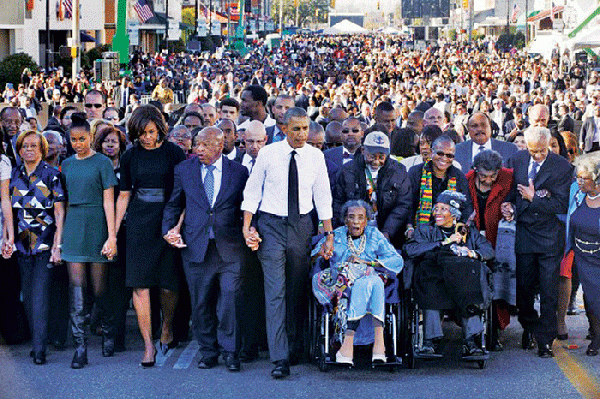
DETROIT — Tens of thousands gathered at Edmund Pettus Bridge in Selma, Ala. on March 7 for the 50th anniversary of “Bloody Sunday”, a brutal police crackdown on civil rights and people marching for it.
The city of Selma is best known for the 1960s Selma Voting Rights Movement and the Selma-to-Montgomery marches, beginning with “Bloody Sunday” on March 7, 1965 and ending with 25,000 people entering Montgomery, Ala. at the end of the last march to press for voting rights.
The African American Civil Rights Movement took place decades ago, but recent events and protests for Black equality sweeping the nation show the community’s struggle is far from over.
“We have a long way to go,” said Minister Malik Shabazz, the head of the Marcus Garvey Movement/New Black Panther Nation. “When we have White cops killing a Black man on camera and getting away with it, we have a long way to go.”
On the anniversary of “Bloody Sunday” President Obama delivered a passionate speech in Selma, highlighting the history of the African American civil rights movement. Young activists held up placards and wore t-shirts remembering Eric Garner with the words “I Can’t Breathe” and had pins with Michael Brown’s face and the phrase “Black Lives Matter.”
Garner and Brown were African American men killed by police in New York City and Ferguson, MO., respectively. The circumstances of both men’s deaths led to protests in those cities.
The Twitter hashtag “MuslimLivesMatter” has been trending on Facebook in the wake of several suspected hate crimes, including the December death of a 15-year-old Muslim boy who died from blood loss after his legs were severed when he was hit by an SUV outside the Somali Center of Kansas City, MO; the murder of three Muslims shot execution style last month at their home in Chapel Hill, N.C. and the fatal shooting this month of a Muslim immigrant in Texas who was killed while taking photos of snow with his wife.
“African and Arab Americans are both minorities existing in a power structure that wasn’t designed for them,” Shabazz said. “No one should suffer humiliation, alienation, segregation or any type of behavior because of the pigmentation of their skin or choice of religion. When it come down to it, human beings are human beings.”
In many ways, Muslims and African Americans face parallel challenges with respect to discrimination. Both Black churches and Muslim Mosques (and other Islamic institutions) have been attacked over the course of the country’s history. On Sept. 15, 1963, four girls were killed in Birmingham, Ala. when the predominantly-Black 16th Street Baptist Church was bombed. Two more African American youths were shot a few hours later. The bombing had a major impact on the nascent civil rights movement.
Since 9/11, mosques and other Islamic institutions throughout the U.S. have frequently been vandalized. Among other instances, a White supremacist killed six worshipers at a Sikh Temple in Wisconsin in 2013 and last month, a mosque in Houston was set on fire.
Other minority groups, including Jews, Latinos and Asian Americans, have also faced bigotry and racism.
Disputes have emerged when the struggle of African Americans is compared with the challenges other minority groups face regarding discrimination and racism.
“Those arguments are used to pit people against each other,” said Keith Owens, a freelance writer and former editor of the Michigan Chronicle.
Shabazz said Blacks are the most oppressed people on the planet and the country and no one has suffered more than them.
“It is wrong for any person to be oppressed or exploited,” he said. “We all have to work together and unite.”
Khaled Beydoun, a professor at the Barry University School of Law and an Arab American activist, said Americans that identify as both Black and Arab are subject to both broad societal racism as well as intra-racism.
“Arab and Black Americans face state-sponsored and societal forms of racism targeting both dimensions of their identity,” he said. “It is crucial to note that the first Muslims in the U.S. were Black. Enslaved African Muslims comprised 15 percent to 20 percent of the aggregate slave population the antebellum South.
Amid the wave of violence against both Muslims and African Americans, activists from both communities have come together in an effort to work together. The Take On Hate campaign convened simultaneous events in Detroit and New York City in December. Both sought to address the prospective coalition between the emergent Black Lives Matter Movement and Arab-American civil rights efforts. The two events brought together hundreds of participants from the Arab and African American communities, setting a key precedent for prospective bridge-building, candid communication and— for Americans that identify as both Arab and Black— an invaluable space.
“African and Arab Americans are still viewed as “others” even though this is their country,” Shabazz said.






Leave a Reply